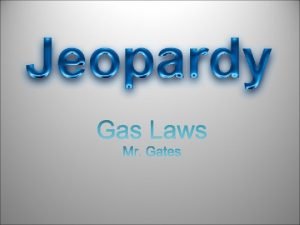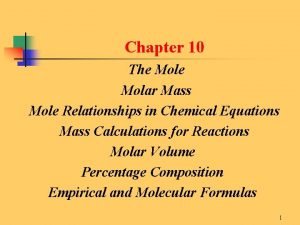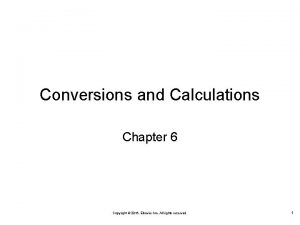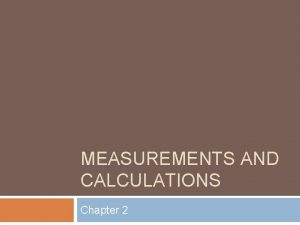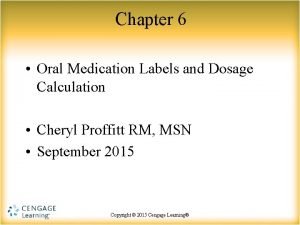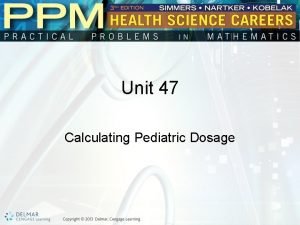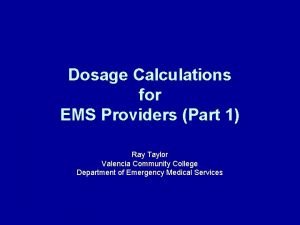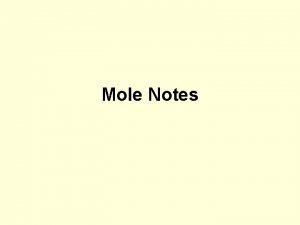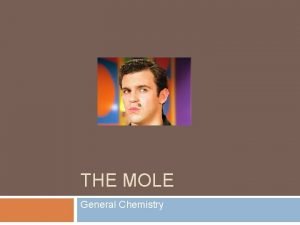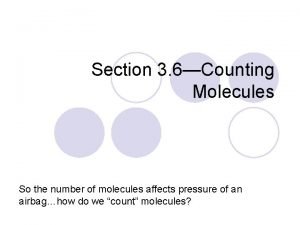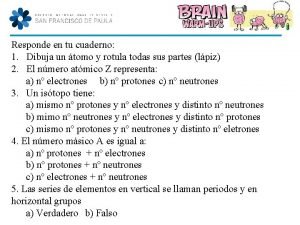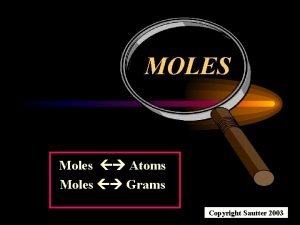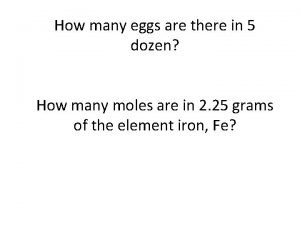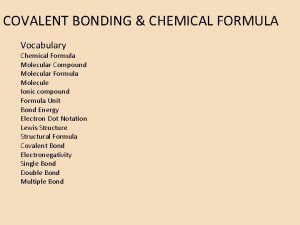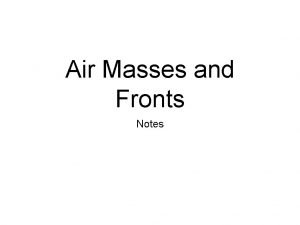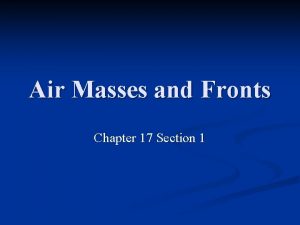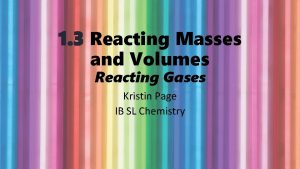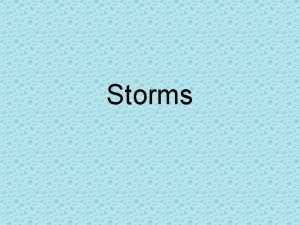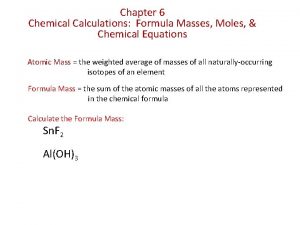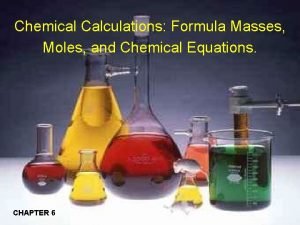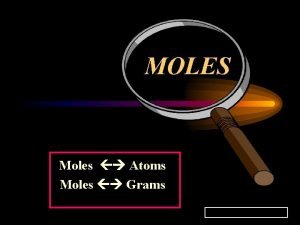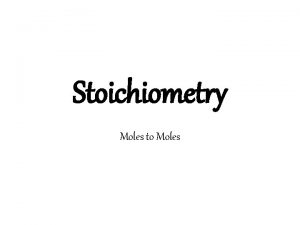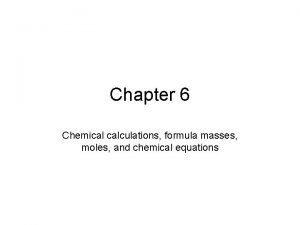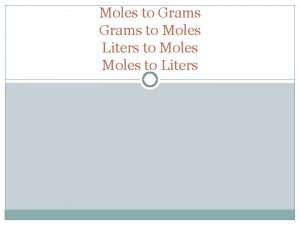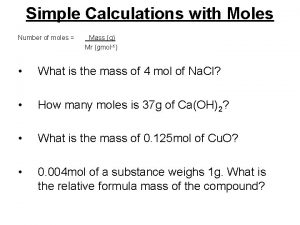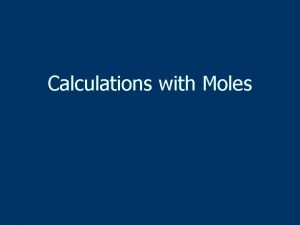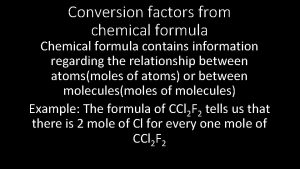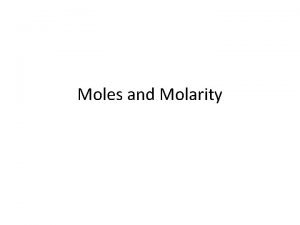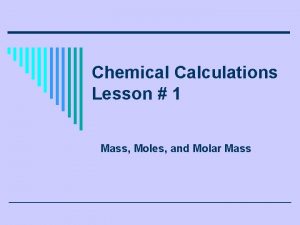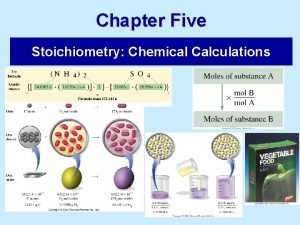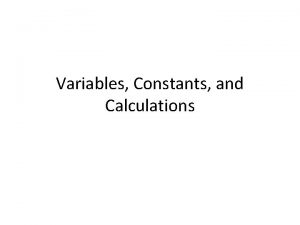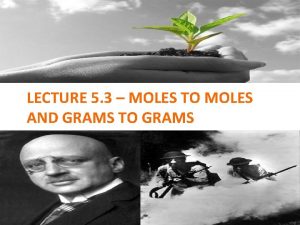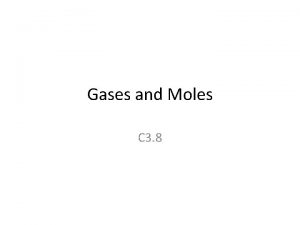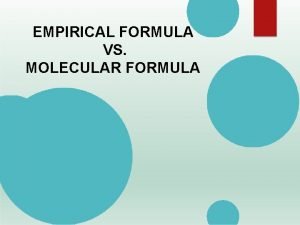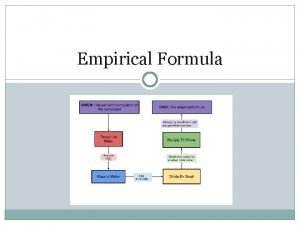Chapter 6 Chemical Calculations Formula Masses Moles and
















































- Slides: 48

Chapter 6. Chemical Calculations: Formula Masses, Moles, and Chemical Equations Introduction to Inorganic Chemistry Instructor Dr. Upali Siriwardane (Ph. D. Ohio State) E-mail: upali@latech. edu Office: 311 Carson Taylor Hall ; Phone: 318 -257 -4941; Office Hours: MWF 8: 00 -9: 00 and 11: 00 -12: 00; TR 10: 00 -12: 00 Contact me trough phone or e-mail if you have questions Online Tests on Following days March 24, 2017: Test 1 (Chapters 1 -3) April 10, 2017 : Test 2 (Chapters 4 -5) April 28, 2017: Test 3 (Chapters 6, 7 &8) May 12, 2017 : Test 4 (Chapters 9, 10 &11) May 15, 2017: Make Up Exam: Chapters 1 -11). 1

Chapter 6 Table of Contents 6. 1 6. 2 6. 3 6. 4 6. 5 6. 6 6. 7 6. 8 Formula Masses The Mole: A Counting Unit for Chemists The Mass of a Mole Chemical Formulas and the Mole Concept The Mole and Chemical Calculations Writing and Balancing Chemical Equations and the Mole Concept Chemical Calculations Using Chemical Equations Copyright © Cengage Learning. All rights reserved 2

Section 6. 1 Formula Masses Atomic Mass of Cu 63. 55 amu (g/mol) Formula Mass of Ca. Cl 2 = 110. 98 amu (g/mol) (2 × 35. 45) + 40. 08 Molecular Mass of H 2 O = 18. 02 amu (g/mol) (2 × 12. 01. 45) + (6 x 1. 008) Copyright © Cengage Learning. All rights reserved 3

Section 6. 2 The Mole: A Counting Unit for Chemists A Mole • The amount of a substance that contains as many elementary particles (atoms, molecules, or formula units) as there atoms in exactly 12 grams of pure 12 C. • 1 mole of anything = 6. 02 x 1023 units of that thing (Avogadro’s number). • 1 mole C = 6. 022 x 1023 C atoms = 12. 01 g C Copyright © Cengage Learning. All rights reserved 4

Section 6. 3 The Mass of a Mole Molar Mass (g/mol) [molecular or formula mass (weight)] Mass in grams of one mole of the substance: Molar Mass of N = 14. 01 g/mol Molar Mass of H 2 O = 18. 02 g/mol (molecular weight) (2 × 1. 008) + 16. 00 Molar Mass of Ba(NO 3)2 = 261. 35 g/mol (Formula Weight) 137. 33 + (2 × 14. 01) + (6 × 16. 00) Copyright © Cengage Learning. All rights reserved 5

Section 6. 3 The Mass of a Mole Exercise Calculate the mass, in grams, of a 2. 5 -mole sample of ethane, C 2 H 6. Copyright © Cengage Learning. All rights reserved 6

Section 6. 3 The Mass of a Mole Exercise Calculate the mass, in grams, of a 2. 5 -mole sample of ethane, C 2 H 6. Molecular weight of C 2 H 6 (2 × 12. 01. 45) + (6 x 1. 008) = 30. 068 g/mol C 2 H 6 Copyright © Cengage Learning. All rights reserved 7

Section 6. 3 The Mass of a Mole Exercise Calculate the mass, in grams, of a 2. 5 -mole sample of ethane, C 2 H 6. 75 g C 2 H 6 Copyright © Cengage Learning. All rights reserved 8

Section 6. 3 The Mass of a Mole Exercise Calculate the number of moles in 50. 0 g of H 2 O. Copyright © Cengage Learning. All rights reserved 9

Section 6. 3 The Mass of a Mole Exercise Calculate the number of moles in 50. 0 g of H 2 O. Molecular weight of H 2 O (2 × 1. 008) + 16. 00 = 18. 016 g/mol H 2 O Copyright © Cengage Learning. All rights reserved 10

Section 6. 3 The Mass of a Mole Exercise Calculate the number of moles in 50. 0 g of H 2 O. Molecular weight of H 2 O = 18. 016 g/mol 2. 78 mol H 2 O Copyright © Cengage Learning. All rights reserved 11

Section 6. 4 Chemical Formulas and the Mole Concept Chemical Formula – Microscopic View • The numerical subscripts in a chemical formula give the number of atoms of the various elements present in 1 formula unit of the substance. – In one molecule of P 2 O 5, two atoms of phosphorus and five atoms of oxygen are present. Copyright © Cengage Learning. All rights reserved 12

Section 6. 4 Chemical Formulas and the Mole Concept Chemical Formula – Macroscopic View (mole) • Indicates the number of moles of atoms of each element present in one mole of a substance. – In one mole of P 2 O 5, two moles of phosphorus and five moles of oxygen are present. Copyright © Cengage Learning. All rights reserved 13

Section 6. 4 Chemical Formulas and the Mole Concept Exercise How many moles of carbon atoms and hydrogen atoms are present in a 2. 5 -mole sample of ethane, C 2 H 6? Mole to atom conversion factor is used based on number of atoms in the formula Then use mole to atom conversion to get number atoms Copyright © Cengage Learning. All rights reserved 14

Section 6. 4 Chemical Formulas and the Mole Concept Exercise How many moles of carbon atoms and hydrogen atoms are present in a 2. 5 -mole sample of ethane, C 2 H 6? Copyright © Cengage Learning. All rights reserved 15

Section 6. 5 The Mole and Chemical Calculations Let’s Put It All Together! Copyright © Cengage Learning. All rights reserved 16

Section 6. 5 The Mole and Chemical Calculations Concept Check Which of the following is closest to the average mass of one atom of copper? a) 63. 55 g b) 52. 00 g c) 58. 93 g d) 65. 38 g e) 1. 055 x 10 -22 g Copyright © Cengage Learning. All rights reserved 17

Section 6. 5 The Mole and Chemical Calculations Concept Check Which of the following is closest to the average mass of one atom of copper? a) 63. 55 g b) 52. 00 g c) 58. 93 g d) 65. 38 g e) 1. 055 x 10 -22 g Copyright © Cengage Learning. All rights reserved 18

Section 6. 5 The Mole and Chemical Calculations Concept Check Calculate the number of copper atoms in a 63. 55 g sample of copper. Copyright © Cengage Learning. All rights reserved 19

Section 6. 5 The Mole and Chemical Calculations Concept Check Calculate the number of copper atoms in a 63. 55 g sample of copper. 6. 022× 1023 Cu atoms Copyright © Cengage Learning. All rights reserved 20

Section 6. 5 The Mole and Chemical Calculations Concept Check Which of the following 100. 0 g samples contains the greatest number of atoms? a) Magnesium b) Zinc c) Silver Copyright © Cengage Learning. All rights reserved 21

Section 6. 5 The Mole and Chemical Calculations Concept Check Which of the following 100. 0 g samples contains the greatest number of atoms? a) Magnesium b) Zinc c) Silver Copyright © Cengage Learning. All rights reserved 22

Section 6. 5 The Mole and Chemical Calculations Exercise Rank the following according to number of atoms (greatest to least): a) 107. 9 g of silver b) 70. 0 g of zinc c) 21. 0 g of magnesium a) b) c) Copyright © Cengage Learning. All rights reserved 23

Section 6. 5 The Mole and Chemical Calculations Exercise Rank the following according to number of atoms (greatest to least): a) 107. 9 g of silver b) 70. 0 g of zinc c) 21. 0 g of magnesium b) Copyright © Cengage Learning. All rights reserved a) c) 24

Section 6. 5 The Mole and Chemical Calculations Exercise Consider separate 100. 0 gram samples of each of the following: H 2 O, N 2 O, C 3 H 6 O 2, CO 2 – Rank them from greatest to least number of oxygen atoms. H 2 O = 18. 02, N 2 O = 46. 01 , C 3 H 6 O 2= 74. 09, CO 2 = 44. 01 g/mol H 2 O = 5. 549, N 2 O = 2. 173 , C 3 H 6 O 2= 1. 349, O = 5. 549, O = 2. 173, Copyright © Cengage Learning. All rights reserved CO 2 = 2. 272 mol C 3 H 6 O 2= 2. 698, CO 2 = 4. 544 mol O 25

Section 6. 5 The Mole and Chemical Calculations Exercise Consider separate 100. 0 gram samples of each of the following: H 2 O, N 2 O, C 3 H 6 O 2, CO 2 – Rank them from greatest to least number of oxygen atoms. H 2 O, CO 2, C 3 H 6 O 2, N 2 O 5. 549 4. 544 Copyright © Cengage Learning. All rights reserved 2. 698 2. 173 mol O 26

Section 6. 6 Writing and Balancing Chemical Equations A Representation of a Chemical Reaction • A written statement that uses chemical symbols and chemical formulas to describe the changes that occur in a chemical reaction. C 2 H 5 OH + 3 O 2 2 CO 2 + 3 H 2 O reactants products • Reactants are always placed on the left side of the arrow, products are always placed on the right side of the arrow. Copyright © Cengage Learning. All rights reserved 27

Section 6. 6 Writing and Balancing Chemical Equations C 2 H 5 OH + 3 O 2 2 CO 2 + 3 H 2 O When the equation is balanced. • All atoms present in the reactants are accounted for in the products. • 1 mole of ethanol reacts with 3 moles of oxygen to produce 2 moles of carbon dioxide and 3 moles of water. Copyright © Cengage Learning. All rights reserved 28

Section 6. 6 Writing and Balancing Chemical Equations Equation Coefficient • A number that is placed to the left of a chemical formula in a chemical equation; it changes the amount, but not the identity of the substance. • The coefficients in the balanced equation have nothing to do with the amount of each reactant that is used/given in the problem. Copyright © Cengage Learning. All rights reserved 29

Section 6. 6 Writing and Balancing Chemical Equations • The balanced equation represents a ratio of reactants and products, not what actually “happens” during a reaction. • Use the coefficients in the balanced equation to calculate/decide the amount of each reactant that is used, and the amount of each product that is formed. Copyright © Cengage Learning. All rights reserved 30

Section 6. 6 Writing and Balancing Chemical Equations Guidelines for Balancing Chemical Equations 1. Examine the equation and pick one element to balance first. 2. Then pick a second element to balance, and so on. 3. As a final check, count atoms on each side of the equation. Copyright © Cengage Learning. All rights reserved 31

Section 6. 6 Writing and Balancing Chemical Equations https: //www. youtube. com/watch? v=o. DVsw. Hf. ZJz. Y To play movie you must be in Slide Show Mode PC Users: Please wait for content to load, then click to play Mac Users: CLICK HERE Copyright © Cengage Learning. All rights reserved 32

Section 6. 6 Writing and Balancing Chemical Equations Exercise Which of the following correctly balances the chemical equation given below? Ca. O + C Ca. C 2 + CO 2 I. III. IV. Ca. O 2 + 3 C Ca. C 2 + CO 2 2 Ca. O + 5 C 2 Ca. C 2 + CO 2 Ca. O + (2. 5)C Ca. C 2 + (0. 5)CO 2 4 Ca. O + 10 C 4 Ca. C 2 + 2 CO 2 Copyright © Cengage Learning. All rights reserved 33

Section 6. 6 Writing and Balancing Chemical Equations Exercise Which of the following correctly balances the chemical equation given below? Ca. O + C Ca. C 2 + CO 2 I. III. IV. Ca. O 2 + 3 C Ca. C 2 + CO 2 2 Ca. O + 5 C 2 Ca. C 2 + CO 2 Ca. O + (2. 5)C Ca. C 2 + (0. 5)CO 2 4 Ca. O + 10 C 4 Ca. C 2 + 2 CO 2 Copyright © Cengage Learning. All rights reserved 34

Section 6. 6 Writing and Balancing Chemical Equations Concept Check Which of the following are true concerning balanced chemical equations? There may be more than one true statement. I. The number of molecules is conserved. II. The coefficients tell you how much of each substance you have. III. Atoms are neither created nor destroyed. The coefficients indicate the mass ratios of the substances used. IV. The sum of the coefficients on the reactant side equals the sum of the coefficients on the product side. Copyright © Cengage Learning. All rights reserved 35

Section 6. 6 Writing and Balancing Chemical Equations Concept Check Which of the following are true concerning balanced chemical equations? There may be more than one true statement. I. The number of molecules is conserved. II. The coefficients tell you how much of each substance you have. III. Atoms are neither created nor destroyed. IV. The coefficients indicate the mass ratios of the substances used. V. The sum of the coefficients on the reactant side equals the sum of the coefficients on the product side. Copyright © Cengage Learning. All rights reserved 36

Section 6. 6 Writing and Balancing Chemical Equations Notice • The number of atoms of each type of element must be the same on both sides of a balanced equation. • Subscripts must not be changed to balance an equation. • A balanced equation tells us the ratio of the number of molecules/units which react and are produced in a chemical reaction. • Coefficients can be fractions, although they are usually given as lowest integer multiples. Copyright © Cengage Learning. All rights reserved 37

Section 6. 7 Chemical Equations and the Mole Concept Coefficients in a Balanced Chemical Equation C 2 H 5 OH + 3 O 2 2 CO 2 + 3 H 2 O • One molecule of C 2 H 5 OH reacts with three molecules of O 2 to produce two molecules of CO 2 and three molecules of H 2 O. • One mole of C 2 H 5 OH reacts with three moles of O 2 to produce two moles of CO 2 and three moles of H 2 O. Copyright © Cengage Learning. All rights reserved 38

Section 6. 7 Chemical Equations and the Mole Concept Can Be Used to Generate mole Conversion Factors C 2 H 5 OH + 3 O 2 2 CO 2 + 3 H 2 O • 1 mole of C 2 H 5 OH produces 2 moles of CO 2 and 3 moles of H 2 O. Copyright © Cengage Learning. All rights reserved 39

Section 6. 7 Chemical Equations and the Mole Concept Can Be Used to Generate Conversion Factors C 2 H 5 OH + 3 O 2 2 CO 2 + 3 H 2 O 1 mole of C 2 H 5 OH reacts with 3 moles of O 2. Conversion factors: Are there more? Copyright © Cengage Learning. All rights reserved 40

Section 6. 8 Chemical Calculations Using Chemical Equations Stoichiometric Calculations • Chemical equations can be used to relate the masses of reacting chemicals through moles. Copyright © Cengage Learning. All rights reserved 41

Section 6. 8 Chemical Calculations Using Chemical Equations Calculating Masses of Reactants and Products in Reactions 1. Balance the equation for the reaction. 2. Convert the known mass of the reactant or product to moles of that substance. 3. Use the balanced equation to set up the appropriate mole ratios or conversion factors. 4. Use the appropriate mole ratios to calculate the number of moles of desired reactant or product. 5. Convert from moles back to grams if required by the problem. Copyright © Cengage Learning. All rights reserved 42

Section 6. 8 Chemical Calculations Using Chemical Equations Calculating Masses of Reactants and Products in Reactions g/MM Copyright © Cengage Learning. All rights reserved g/MM 43

Section 6. 8 Chemical Calculations Using Chemical Equations Exercise (Part I) Methane (CH 4) reacts with the oxygen in the air to produce carbon dioxide and water. Ammonia (NH 3) reacts with the oxygen in the air to produce nitrogen monoxide and water. – Write balanced equations for each of these reactions. Copyright © Cengage Learning. All rights reserved 44

Section 6. 8 Chemical Calculations Using Chemical Equations Exercise (Part I) Methane (CH 4) reacts with the oxygen in the air to produce carbon dioxide and water. CH 4 + 2 O 2 CO 2 + 2 H 2 O Ammonia (NH 3) reacts with the oxygen in the air to produce nitrogen monoxide and water. 4 NH 3 + 5 O 2 4 NO + 6 H 2 O – Write balanced equations for each of these reactions. Copyright © Cengage Learning. All rights reserved 45

Section 6. 8 Chemical Calculations Using Chemical Equations Exercise (Part II) Methane (CH 4) reacts with the oxygen in the air to produce carbon dioxide and water. Ammonia (NH 3) reacts with the oxygen in the air to produce nitrogen monoxide and water. – What mass of ammonia would produce the same amount of water as 1. 00 g of methane reacting with excess oxygen? Copyright © Cengage Learning. All rights reserved 46

Section 6. 8 Chemical Calculations Using Chemical Equations Let’s Think About It • Where are we going? – To find the mass of ammonia that would produce the same amount of water as 1. 00 g of methane reacting with excess oxygen. • How do we get there? – We need to know: • How much water (limiting reactant) is produced from 1. 00 g of methane and excess oxygen. • How much ammonia is needed to produce the amount of water calculated above. Copyright © Cengage Learning. All rights reserved 47

Section 6. 8 Chemical Calculations Using Chemical Equations Exercise (Part II) Mole ratio: 1 mol CH 4 = 2 mol H 2 O 4 mol NH 3 = 6 mol H 2 O – What mass of ammonia would produce the same amount of water as 1. 00 g of methane reacting with excess oxygen? 1. 42 g Copyright © Cengage Learning. All rights reserved 48
 If i place 3 moles of n2 and 4 moles of o2 in a 35l
If i place 3 moles of n2 and 4 moles of o2 in a 35l Structural steel connection calculations calculations
Structural steel connection calculations calculations Formula of mol
Formula of mol Chapter 7 review chemical formulas and chemical compounds
Chapter 7 review chemical formulas and chemical compounds 7-3 practice problems chemistry answers
7-3 practice problems chemistry answers The calculations of quantities in chemical reactions
The calculations of quantities in chemical reactions Are kc and kp equal
Are kc and kp equal What formula relates moles, mass and mr?
What formula relates moles, mass and mr? Chapter 2 measurements and calculations
Chapter 2 measurements and calculations Conversions and calculations chapter 6
Conversions and calculations chapter 6 Measurements and calculations chapter 2 test
Measurements and calculations chapter 2 test Medicine dose calculation formula
Medicine dose calculation formula Dosage calculation formula
Dosage calculation formula Body surface area dose formula
Body surface area dose formula Desired dose formula
Desired dose formula H moles formula
H moles formula Amu vs molar mass
Amu vs molar mass Whats a representative particle
Whats a representative particle Molar mass road map
Molar mass road map Mole road map chemistry
Mole road map chemistry Formula units
Formula units Formula de numero de moles
Formula de numero de moles Moles to atoms
Moles to atoms Convert mass to moles
Convert mass to moles Moles to molecules
Moles to molecules Moles to grams
Moles to grams 5 dozen of 50 grams
5 dozen of 50 grams What is the significance of a chemical formula
What is the significance of a chemical formula What is the difference between molecule and compound
What is the difference between molecule and compound Tetraphosphorus octoxide formula
Tetraphosphorus octoxide formula Two astronauts of masses 60 kg and 80 kg
Two astronauts of masses 60 kg and 80 kg Air masses and their characteristics
Air masses and their characteristics Area of low pressure where air masses meet and rise
Area of low pressure where air masses meet and rise Air masses and fronts
Air masses and fronts Air mass
Air mass Air masses form in the tropics and have low pressure
Air masses form in the tropics and have low pressure North american air masses
North american air masses Reacting masses and volumes
Reacting masses and volumes Masses of cells form and steal nutrients from healthy cells
Masses of cells form and steal nutrients from healthy cells What letters designate an air mass from the gulf of mexico?
What letters designate an air mass from the gulf of mexico? Chemical reactions section 2 classifying chemical reactions
Chemical reactions section 2 classifying chemical reactions Section 2 classifying chemical reactions
Section 2 classifying chemical reactions Section 1 chemical changes
Section 1 chemical changes Chapter 10 chapter assessment chemical reactions answers
Chapter 10 chapter assessment chemical reactions answers Chapter 9 chemical reactions answers
Chapter 9 chemical reactions answers Air masses in north america
Air masses in north america Jet stream map
Jet stream map Ocluded fronts
Ocluded fronts Large rotating air mass
Large rotating air mass
